A STAR WARS week-end wrap-up WRAPS it UP
SO....ENJOY. AND READ SLOWLY. HECK, DO LIKE ODDBOB, AND MOVE YOUR LIPS!
Star Wars Fan Films Audience Choice Polls Now Open
For nearly 30 years, one characteristic of the Star Wars films has remained constant: its ability to inspire. Most writers, illustrators, sculptors, and musicians can identify at least one facet of the films that motivated their artistic aspirations, be it the mythic storytelling, the dazzling effects, or its enduring status as an artwork for the ages. Of course, this rule applies most profoundly to the custodians of the medium itself -- the filmmakers.
Celebrating the fifth year in which filmmakers inspired by the Star Wars saga are officially recognized by Lucasfilm Ltd., and George Lucas himself, atomfilms.com begins hosting the Star Wars Fan Film Audience Choice Awards today.
Between June 20 and July 5, fans can preview the top ten finalists in this year's SWFFA at atomfilms.com, which include such titles as:
Blue Milk
Confessions
The Dating Show
Han Shoots First
Lab 1138
Memoirs of a Padawan
Pimp My Ship Up
Pitching Lucas
sith'd
Tebok the Ewok
To streamline the voting process, fans will no longer need to register for a membership to vote, and the voting itself is anonymous. Also, safeguards are in place to ensure that only one vote is taken per user, although this shouldn't discourage viewing the entries as many times as you want!
Winners in all categories, including the Audience Choice Award, will be announced at the San Diego Comic-Con Thursday evening, July 20th.
Be sure to head on over to atomfilms.com today to cast your vote, since the polls will be closing on July 5! EDITOR'S NOTE: THESE ARE FUN. I DON'T THINK THE QUALITY IS ANYWHERE NEAR LAST YEAR'S. BUT STILL FUN. (BE SURE AND CHECK OUT THE CLEVER SPOOFS IN "PITCHING LUCAS")
Bernie Loomis Remembered
A Sizable Contribution to Star Wars

Star Wars fans and toy collectors recently mourned the passing of one of toydom's biggest and brightest luminaries, Bernard Loomis. Loomis, or Bernie, as he was known in the trade, was president of Kenner Products between 1970-1978 and is probably best known among Star Wars collectors as the man who invented the 3 3/4-inch action figure, which has since become an industry standard.
"In all of my travels, I have heard the story told many different ways and have actually heard many different people claiming credit for that innovation," says Howard Roffman, President of Lucas Licensing. "But the most credible stories to me go back to Bernie."
Roffman, who came on as a staff attorney with Lucasfilm in 1980 and handled many of the licensing affairs for The Empire Strikes Back, became quickly acquainted with Loomis' bigger-than-life reputation in the toy business. By the time Empire was released, the Kenner engine was already in high gear delivering new waves of sequel-based action figures struck from the die cast by Bernie Loomis three years earlier.
"So the way that the story goes," continues Roffman, "is that he and the original designers at the time -- Dave Okada and Mark Boudreaux -- were sitting around trying to figure out how tall to make the figures, and Bernie put his thumb and index finger up and said, 'the figures need to be this big.' He made Dave come over with a measuring stick and measure the distance between his thumb and index finger, and it was 3 3/4 inches. Some people were skeptical [of the size] at the beginning because they were thinking, who wants to buy a tiny little figure like that? But Bernie was resolute, as the story goes, that this was how big they needed to be, because you could collect a lot of them and they would fit in the vehicles."
But Loomis' legacy extends far beyond the mere scale of the world's most popular action figures. He launched several successful toy lines throughout his career, including Strawberry Shortcake, and The Six Million Dollar Man. EDITOR'S NOTE: THANKS FOR THE 3 AND 3/4" STANDARD AND ALL. BUT I THINK THERE'S PROBABLY GOING TO BE SOME TIME IN LIMBO FOR THAT DISGUSTING STRAWBERRY CHICK.
Roffman, however, believes that Loomis will be most remembered for his love of the business.
"He was just an effervescently creative guy who had a real passion for the toy business. He represents the old breed of toy executive, somebody who isn't very moved by what have become the traditional business disciplines of research and numbers. He was an idea guy, a really creative guy, and that's what I think people really loved about him. That's why he made such a big impact on the toy business -- it was just in his bones."
Like the Star Wars Early Bird kit that promised the arrival of the first four Star Wars action figures by mail (another Loomis success story), the legacy of Bernie Loomis remains a gift that is sure to keep on giving for years to come.
EDITOR'S NOTE: LET'S TAKE A QUICK BREAK TO MAKE A NOTE OF SOMETHING I ABSOLUTELY MUST HAVE ---
Exclusive Star Wars Coaster Set

EDITOR'S NOTE: PERFECT FOR OUR RPG SESSIONS, HUH!!??? MUST HAVE MUST HAVE MUST HAVE!
There's nothing like summer parties and backyard barbeques to bring friends, and enemies, together. Whether your allegiance lies with the Rebel Alliance or the Galactic Empire, StarWarsShop's exclusive set of Star Wars coasters is just what you need to bridge the gap between your local idealistic crusader and Imperial invader.This set of four circular coasters feature two Imperial and two Rebel insignias surrounded by a sturdy plastic base and rubber edge that securely grips whatever surface it's resting on. The set also includes a custom tray holder for the coasters, with the classic "Star Wars is Forever" slogan displayed on the front.
Make sure to get this great set of exclusive coasters for your next Star Wars shindig from StarWarsShop today!
PRE-ORDER ITEM: Ships Jul 2006
Our Price: $16.99
Prototype pictured. Final product is subject to change.
The Man Who Makes Monsters
Elliot and E.T. floating on a bicycle. The metallic, self-healing T-1000 in Terminator 2. A rampaging T-rex in Jurassic Park. Dennis Muren has built some of cinema's iconic images.
A senior visual effects supervisor at George Lucas' Industrial Light & Magic, Muren is a pioneer of computer-generated imagery.
But before he revolutionized special effects, Muren made monsters the old-fashioned way.
His 1967 creature feature, The Equinox, used stop-motion animation and matte paintings to tell the story of an ancient book that, once opened, unleashes a slew of terrifying monsters. EDITOR'S NOTE: THIS IS WHY I BUY NEW BOOKS.
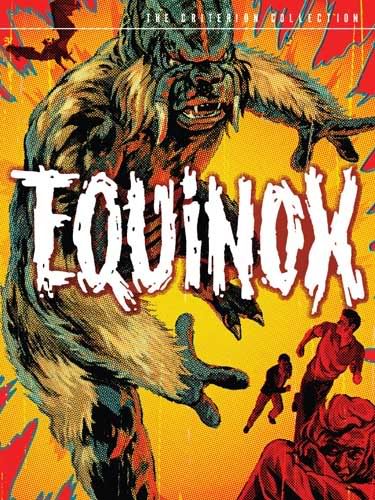
The spirit of King Kong can be seen in Dennis Muren's The Equinox, released on DVD some 40 years after it was completed. Muren went on to win eight Oscars, with seven other nominations, as a special effects master.
Now the Criterion Collection, best known for its high-end catalog of works by Fellini, Bergman and Godard, is releasing Equinox. That means a $6,500, effects-driven feature -- written by teenagers and starring amateur actors -- will share shelf space with Wild Strawberries and The Seven Samurai.
Muren started the film as a teenager on summer break, finished it two years later and then sold it to a B-movie producer, who re-cut and released it.
In the 35 years since, Muren's legend has grown: He's won nine Oscars (more than anyone alive), helped Lucas launch the Star Wars franchise, and become the first effects master with a star on the Hollywood Walk of Fame. And his DIY feature, though rarely seen, has taken on the stature of Very Important Movie.
Muren spoke with Wired News about Equinox and the transition to digital effects from his office at ILM.
Wired News: Why did you decide to spend your summer vacation making a special-effects extravaganza?
Dennis Muren: I was 17. I had a 16-mm camera. I had done all of these movies, these special-effects scenes, since I was a kid. The only people who had seen them were families and friends. I said to myself, "Why don't we just make a movie?" The idea was that I could sell it to a local TV channel and then other people would see it. That's how it started -- I wanted the effects work I was doing to be seen by other people.
WN: It must have been a crash course in filmmaking.
Muren: I learned more making this movie than I could ever have at film school. You discover what films are really all about. It's all plastic and malleable. If a story point isn't right, you might need to re-shoot. You have to get everyone together, and then the wardrobe might not match, or there is a problem with the camera and you have to get the shot on the 100-foot roll of film because that's all you brought with you.
Making this movie forced me to think intentionally and to not rely on other people to solve my problems. That's something I've used through my whole career.
WN: Equinox isn't a masterpiece -- you even make fun of it during the DVD commentary. But there's something primal and touching about the way your monsters move. You don't often get that kind of charge out of digital effects.
Muren: You very much feel Equinox was made by people. It's a handmade object. That feeling is something that's been lost. The computer work today is so seamless, but it can be very cold. The trick is to make it feel handmade, like it's not made by a machine, but by people using machines. A lot of folks doing effects can churn the material out, but they aren't giving it any soul. Soul is inherent to the old style, the stop-motion and matte painting. EDITOR'S NOTE: IT KINDA SOUNDS LIKE HE'S CRITICIZING HIS OWN ILM WORK, DOESN'T IT?
WN: Back then, visual effects were a hands-on process. Today, someone with programming skills can build a career in special effects without ever having touched a model.
Muren: I learned by holding things and feeling them and animating them. Going through that process really bonds you to the project and to the moment. What goes on in (computer-generated effects) is you modify and modify and modify. The process is almost never done. In the earlier, linear way of working, you either got the shot or you didn't. The actors were there, you were running out of film and you needed that shot. There were boundaries you had to work within. That's gone right now. In some ways, that's for the better. You have the opportunities to polish stuff and make it look more real.
WN: How do you inject soul into your computer-generated images?
Muren: I try to view the work like a kid would do, an 8- or 10-year-old kid. There's a switch in my brain I can throw when I'm looking at dailies. Is it too sophisticated? Is it perfect but boring? You have to give it -- I don't want to use the word "edge" -- but some emotion.
WN: Was there a eureka moment when you said to yourself, "The future is digital"?
Muren: Yeah, there was, when we were doing The Abyss.... The imagery we got from that show was so compelling. I saw ways that computers could do it better, and could do stuff you couldn't otherwise imagine doing.... At the end of that, I took a year off of work and bought a 1,200-page textbook on computer graphics and read it.... (And) I bought one of the first scanners being sold -- it was $2,500 or so -- and took it apart the day I got it home, just to see what the sensor looked like. I just had to understand it.
I didn't have any background in computers. They always seemed like a tease. You couldn't do anything on a budget or on time. I work in that world of budgets and schedules, not in the world of research where you have years to figure things out.
WN: When were you able to put it all together?
Muren: T2 was a combination of digital compositing and 3-D (computer-generated imagery). That was the show where everything came together. And then Jurassic took it to the next step, where we gave (the dinosaurs) a skin surface, did it in daylight and got performances that were more like animal behavior.
WN: People used to talk about suspension of disbelief. But everything seems so realistic these days -- I ducked when some of the shrapnel flew in your War of the Worlds battle scenes.
Muren: I think the experience has become more real for viewers. There is much less fantasy. They used to see black-and-white films where the actors would be glowing because of the fog filter the photographer was using.
This stuff is much more real, more like reality TV. It's styled, because it's a movie, but much more seamless. It's not as magical -- it's more representative of reality. In some ways that's really good for the storyteller, because the artifacts or the effects don't get in the way. It comes down to how good the story is. If you aren't distracted by the effects, the movies become more powerful.
WN: Does the bar keep rising? Do you feel pressure to make your killer effects more killer?
Muren: The bar keeps on rising because the tools haven't changed much. We had the motion-control revolution in the '70s and computers in the '80s and '90s. I don't know what's next. But we have been working with the same tool set for 15 years and making incremental improvements. The motion capture looks better. The faces look better. The set extensions are better and the crowds are bigger. But the audiences get used to it. So writers have to come up with stuff that will shock you visually.
WN: It must be amazing to see the success of effects-based movies. When you started, visual effects were the domain of B movies.
Muren: Oh yeah, when I was a kid there was no future in visual effects. Nobody was making them.... But now that people want to see these movies, it's an actual profession. If you loved these movies as a kid, you can follow your dreams and make them yourself. And they'll give you a paycheck. We never thought for a second that Equinox would get us into the business because there was no business. It was just a labor of love.
WN: Do you have a favorite moment with ILM?
Muren: Well, I'd say that whole period when we did T2 and Jurassic Park, just being able to see the dailies. We'd say, "Did we really do this? How is it possible?" I knew how to see every flaw in traditional effects. No matter how you tried, things looked like plastic or wood when they were supposed to be something else. But these images looked real. It felt like we were really on to something, and every day was exciting. Scary, too, because we didn't know when the other shoe would drop, when we'd find the Achilles' heel to this process. It was dangerous. We didn't know if it would work. So we were really on the edge the entire time.
For Jurassic, we had a backup plan for every shot. But actually, as we got going we got better and better shots. We got more confident. We started on the film not knowing if we could get the creatures running. By the end, we were doing closeups on the tyrannosaurus. I never could have committed to Steven (Spielberg) that we could do closeups. I had no idea.
WN: Do you talk to any of the old-timers about CGI? How would Willis O'Brien have felt about the films you make today? Would he be amazed?
Muren: I talk to Ray Harryhausen a lot. The older guys are really torn. They can see the spectacle and the reality of it, but they miss those artifacts, the handmade feeling of it. So it's very bittersweet. EDITOR'S NOTE: HARRYHOUSEN IS STILL ALIVE? HE MUST BE 143 YEARS OLD!
CAPTAIN ANTILLES SPEAKS
When actor Rohan Nichol first stepped foot on the Episode III set in Sydney, Australia, he was thrilled to be playing Captain Antilles -- he just wasn't sure which one. "Because I'm such a huge Star Wars fan, I already knew Alderaan is a peaceful place and that it was destroyed in A New Hope,"EDITOR'S NOTE: BOOM! (AW QUIT YOUR WHINING, OB!) Nichol says. "My research basically consisted of reading a few things about Alderaan, and about Princess Leia and that sort of thing. But the rest of it is actually within me, because I'm of the generation that grew up with those films. So when I got the role of Captain Antilles I initially thought, 'Oh man, I'm going to be an X-wing fighter pilot! And he's the man; he survives. He's great!'"
It wasn't until he arrived on the Sydney set that he understood he'd be playing Captain Raymus Antilles, owner of R2-D2 and C-3PO. "I honestly thought I was playing a younger version of Wedge. Either way, it's been an honor!"
Though the role wasn't a major part in Revenge of the Sith, Nichols was excited to share the screen with actors Jimmy Smits (Bail Organa) and Anthony Daniels (C-3PO).
"The first scene that I was in, basically I'm reporting to Bail Organa, and just letting him know that we've located a Jedi homing beacon," Nichol says. "And it wasn't without a bit of a scrap up -- I'm sort of cut up a little bit. When I say it, my character is kind of stunned that the clones seem to be directionless; they don't have a leader. And so Senator Organa tells me that we'd better intercept the Jedi before the clones regroup. In the second scene basically Organa entrusts R2-D2 and C-3PO to my care, and tells me to treat them well, and that he wants C-3PO's mind erased."
One of Nichol's favorite memories of his role was turning an accidental shaving incident into a detail that built character.
"I came on to the set and I had a bit of a nick on my chin from shaving," Nichol recalls. "The nick was being very troublesome and it wouldn't stop bleeding, so it had formed an annoying mark. So when I met George Lucas on the set, I apologized for the nick and he said jokingly that I must have gotten it in the Clone Wars! I said, 'That's right, I did!' And that moment made me realize how relaxed Lucas was as a director. For a guy who's got a lot on his shoulders, he's always prepared. I suppose that comes with having a system of people around you who you've done stuff with for ages. Everyone knows their job; everyone knows what the score is. It really was a pleasantly surprising experience."
EDITOR'S NOTE: FOR THOSE OF YOU NOT INTO THE EU (EXPANDED UNIVERSE) ...........OR SITH......... OR EVIL, THIS IS A VERY LONG ARTICLE ABOUT THESE SUBJECTS. SKIP AHEAD.
NO, ODDBOB. YOU STAY.
Evil Never Dies: The Sith Dynasties
By Abel G. Peña
Over the millennia, the Sith have existed in many forms: as a people, as a religion, as a dictatorship, as a philosophy. The Sith have been brought to the brink of extinction time and again, yet they have always found a way to survive. EDITOR'S NOTE: STAR WARS COCKROACHES, THAT'S WHAT THEY ARE! Many times the title of "the last Dark Lord" has been erroneously applied. First the Dark Lord Naga Sadow, vanquished by the Galactic Republic in the Great Hyperspace War 5,000 years before the Battle of Yavin, was thought to be the last. Then a thousand years later, the fallen Jedi Exar Kun was considered the last of these dark siders' twisted kind.
Then Darth Nihilus... then Lord Kaan... then Darth Vader.
In the words of the arcane scholar Murk Lundi, the Sith, though oft-vanquished, understood and fully embraced a fundamental concept that was certain to assure their survival and resurrection -- an idea that most Jedi refused to accept.
Simply, if the will of the Force demands balance, then evil can never die. EDITORS' NOTE: SO THERE'S HOPE FOR YOU YET, OH EVIL ODDBOB.
Since the Beginning
"It is relevant to note that the word 'Sith' can be found in Pre-Corellian lexicons as a term meaning 'due to' or more plainly, 'since.' Sith that time -- wait, that's not right [student laughter] -- since that time, the word has evolved with Corellian phraseology to give us highly useful expressions, such as the expletives, 'Sithspit!' and 'Sithspawn!' [student laughter]." -- Lecture recording from The Lundi Series, Vol. 3: Origins of the Darth Dynasty, Soundbyte Texts
The term Sith was once used to describe a variety of beings, and was not always synonymous with the dark side. Originally not only a cult but a cultured species before they were subjugated by dark Jedi exiles, the blood-colored humanoid Sith people lived a superficially barbaric though surprisingly harmonious existence on their homeworld Korriban. Sentient sacrifices to their gods, dining on bloodsoupEDITOR'S NOTE: YUM. (NOT TO BE CONFUSED WITH BLOODWINE....WHICH IS A COMPLETELY DIFFERENT UNIVERSE? OR BLOODWHINE, WHICH IS WHAT ODDBOB IS DOING RIGHT NOW?) , a rigid and prejudice caste system, and war between nations were all common in Sith culture. These barbarous practices were accepted not as contrary or antagonistic to life, but integral to it. War was quite literally a concept on par with peace or serenity; conceptually, the Sith people did not or could not differentiate one state from the other. There was, ultimately, only existence. EDITOR'S NOTE: YEAH. BUT OTHER THAN ALL THAT, THEY WERE A TRULY LOVELY FOLK.
Some historians have speculated that the attitudes of the early Sith people were owed to a prehistoric encounter between their species and the vampiric beings known as the Anzati. Volfe Karkko, a rare Anzat Jedi known for his prolonged study of one of the Jedi Temple's rare Sith holocrons, was fond of reminding his fellow Knights that the Anzati "remember the very first Sith."
Beyond the anecdotal, though, there is no solid evidence to support this theory.
A peculiarity of the Sith people was their innate tendency toward left-handedness. EDITOR'S NOTE: OH MY GOSH, I KNEW IT! MY MOTHER IS A SITH! (SHE DOESN'T EVEN LIKE STAR WARS. WHICH IS ANOTHER PROOF!) SOUNDS LIKE THE NAME OF A CORUSCANTI SITCOM, DOESN'T IT? ("MY MOTHER IS A SITH" LAUGH. OR ELSE! GIGGLE) This led to their creation of the lanvarok, a forearm-mounted weapon adapted strictly for left-handed use (human Sith Lords later crafted a right-handed version). Pure-blooded Sith were also steadily bred out as their genes were eventually alchemically mixed with those of humanoid dark Jedi. Even after the genetic fusion, the Sith's rigid caste system remained in place. Priests and warriors, called Kissai and Massassi respectively, were two of the prominent classes. Later in their history, those that bore the elevated title of Sith Lord were relatively common, but in 100,000 years of their existence, the Sith only ever had one monarch overlord.
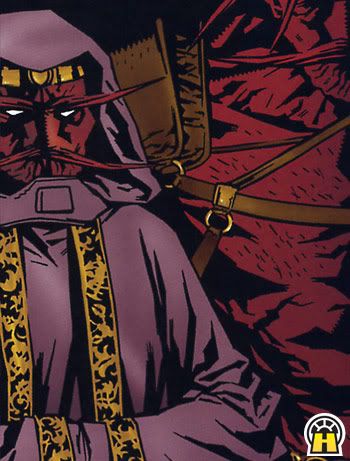
A MASSASSI
Ruling nearly 3,000 years before the rise of the Galactic Republic, King Adas was a massive, regal being encased in majestic ebon warrior armor. Raised from his youth as a chosen being due to the charcoal pigment of his skin, Adas demonstrated great intelligence, fighting prowess, and a tremendous aptitude for Sith magic. With his alchemically forged battle-ax, Adas led the bloody unification of Korriban's disparate nations and became its undisputed world ruler. The Sith people came to believe that King Adas was immortal and that his reign would be eternal.
In fact, Adas was almost three hundred years old and had earned the title Sith'ari (meaning "the Lord" or "overlord") when alien invaders came to Korriban. Misshapen Force-sensitive beings, these Rakatan soldiers of the so-called Infinite Empire first attempted to lull King Adas into their confidence by teaching him how to record his essence into a pyramidal, magical device called a holocron. But the Rakata soon showed their true colors and tried to conquer the Sith people. But even at that ripe age, the Sith King refused to go quietly and introduced the invaders to his oversized axe and the unconquerable will of his people. The dark siders were defeated, but the king gave his life to secure the Sith's freedom. After his death, King Adas' holocron passed to his "Shadow Hand," his trusted advisor and second in command. Without Adas' unifying influence, wars once again raged for rule of the Sith people, with the reigning combatants arrogantly claiming the title of Sith'ari, and eventually forcing a relocation of the Sith capitol to the planet Ziost.
Eventually, almost two-dozen millennia after Adas' death, a proper successor to Adas seemed to come at last. Known in Republic space as the Exiles, traitorous Jedi defeated in a galactic war called the Hundred-Year Darkness arrived on Korriban and cowed the Sith people with their astounding Force abilities, lightsabers, and superior technology. With the help of the ruling king's Shadow Hand, these Jen'jidai, as the Sith called them,EDITOR'S NOTE: CAUSE THEY HAD HEARING PROBLEMS AND COULDN'T HEAR JUST THE 2-SYLLABLE WORD? CAUSE ADDING APOSTROPHES IN THE MID'DLE OF WORDS WAS SITHY-COOL? lured the Sith monarch into their confidence and destroyed him. Never anticipating this stunning sequence of events, the Sith people concluded that the dark Jedi were themselves more powerful gods than even the Sith'ari. Bestowing the Exiles with Adas' holocron, the reign of the first Jen'ari, or "Dark Lord" of the Sith began.
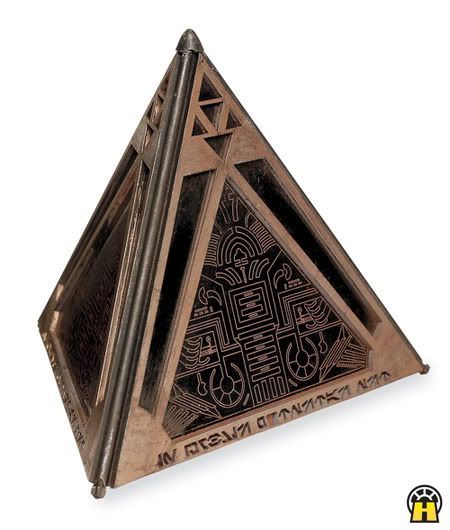
EDITOR'S NOTE: SO THIS IS WHAT A HOLOCRON LOOKS LIKE! (I HAVE NEVER SEEN A PICTURE BEFORE!) COOL! (SO SOME OF THE TEMPLES ON YAVIN ARE SORT OF VERY LARGE HOLOCRONS? IN DESIGN, ANYWAY).
The last lord of the Sith Empire to possess Adas' holocron was Lord Garu, who died around the time of the Great Hyperspace War. The holocron was abandoned on the planet Ashas Ree until its rediscovery centuries later by the fallen Jedi Freedon Nadd. Nadd used it to rule the planet Onderon, where the teachings of King Adas helped usher in a new age of darkness. When the Jedi eventually freed Onderon of the dark side, they gained possession of the Sith holocron and banished it to a place where it could, presumably, never be recovered -- under millions of tons of water on a scarcely known world called Kodai. EDITOR'S NOTE: I'M BETTING 'NEVER TO BE RECOVERED' TURNED OUT TO BE OPTIMISTIC?
The Mecrosa Order
Immediately following their conquest of the Sith people (circa 7,000 years before the Battle of Yavin), a few upstart Exiles, now self-proclaimed Sith Lords, returned to Republic space believing they could revenge themselves on their Jedi enemies with their new knowledge of Sith magic. The attack proved premature, however, and instead they succeeded only in revealing that some Jedi schismatics had found a new home and a people to rule outside of charted Republic space. The true scale of the Sith menace lurking in unknown space remained invisible for millennia, however. Two thousand years later, the Great Hyperspace War indelibly proved to the Jedi how dangerous the Sith Lords could be.
The thoroughness of the Jedi extermination efforts following this first full-scale Sith war was criticized by many as being executed with a gusto rivaling a Bothan declaration of Total War. EDITOR'S NOTE: DOESN'T SOUND LIKE THE JEDI WAY. OR EVEN THE COWBOY WAY. Nevertheless, Sith teachings survived, and a thousand years later, a new war erupted, this time called the Great Sith War. This conflict came to be grouped with a series of major Sith-related encounters that followed soon after: the Mandalorian Wars, the Jedi Civil War, and the Cleansing of the Nine Houses. EDITOR'S NOTE: FOLLOWED BY THE CARPET-CLEANING OF THE HUTT PALACE, THE ROOT-CANAL OF THE WEEQUAY INSURGENCY, AND THE SPIT-BALL FIGHT OF THE JAWAS.
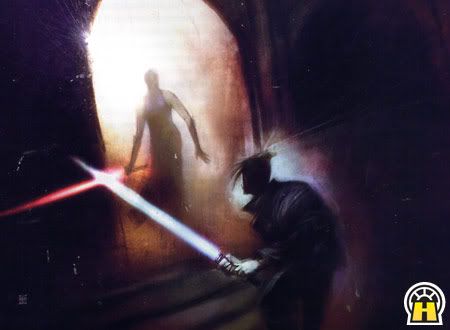
The Mecrosa Order was the focus of the Cleansing. The order started out benevolently enough. Emerging during the Tapani sector's Dynastic Era, approximately a quarter millennium before the Great Sith War, the Mecrosa began as an order of nobles from House Mecetti who took an oath to protect the house against external attack and insurrection. For the next two hundred years, Mecrosa flourished from its castle on the planet Nyssa, gaining wealth and erecting chapter houses and fortresses on Mecetti worlds.
To assist in its crusade, the order also oversaw the creation of an elaborate spy network. It is believed that the virtues of the Mecrosa Order were compromised somewhere during this two century stretch. Jedi from rival House Pelagia insisted that the order's founder, Viscountess Mireya, was the root of Mecrosa's Sith corruption.
When Mecetti High Lord Tritum XI realized there was a threat of inbreeding facing his house, he sought to introduce new noble blood. In one of those all-too-common circumstances when politics and noble pride must be reconciled, Tritum looked to a suitor outside the Tapani region -- to the nobility of a world called Vjun. Vjunite Viscountess Mireya brought to House Mecetti not only her noble pedigree, but Sith teachings as well. Sith rituals were subtly integrated into Mecrosa initiation rites and ceremonies, and soon Sith "lords" of a very different breed terrorized Tapani sector, assassinating Tapani house leaders that appeared to threaten Mecetti power and infecting Pelagia's Jedi with Sith poisons.
The Great Sith War turned out to be advantageous for Tapani citizens, for it focused Jedi attentions toward the Sith in their sector. After crushing Exar Kun, the Jedi collectively turned their might against the Mecrosa Order and flensed the Sith corruption in what came to be known as the Cleansing of the Nine Houses. However, contrary to popular belief, the Jedi didn't destroy the Mecrosa Order itself. The surviving Mecrosa, many of them non-Force-sensitive to begin with, went even deeper underground, trading the flash of Sith magic and supernatural poisons for the silence of frinka venom and martial arts. EDITOR'S NOTE: FRINKA VENOM? NOW I THINK THEY ARE JUST MAKING STUFF UP!
The humbled Mecrosa survived the next 4,000 years, maintaining their secret through careful member selection and their tradition of assassination. Only during the New Sith Wars and the Jedi Purge did the order participate in sector events more actively, respectively poisoning Sith Lady Belia Darzu for her unwanted incursions into Tapani Space and taking revenge against the Pelagian Jedi for their role in decimating Mecrosa during the Cleansing.
It was during the Jedi Purge after the Clone Wars that King Adas' holocron fell back into the hands of Sith descendants, when Mecrosa's most skilled agent Sir Nevil Tritum, snuck his way into Pelagia's holocron library. Despite not having any Force abilities, Tritum reported to his superiors his successful recovery of Adas' holocron from three very dead Jedi guardians.
Some time after the Battle of Endor, the Mecrosa were visited in their fortress on Nyssa by a woman appearing for all the galaxy like the abominable offspring of Darth Vader, requesting access to the order's most ancient documents and their Sith holocron. With little option and a sense of obligation, the Mecrosa ceded to the Dark Lady Lumiya's demands.
The New Sith Sentients EDITOR'S NOTE: IS THIS A ROCK BAND? have often debated what has been the bloodiest, most wasteful war in galactic history. Jedi historians often recall the Jedi Civil War, while retired Old Republic rear-admirals name the Clone Wars. But whether it is referred to as "The War of the Fittest," "The Betrayal," or "The Curse of Qalydon,"EDITOR'S NOTE: BUT I JUST CALL IT FRED. the Sith invariably cite the New Sith Wars.
The Old Sith Wars neutralized the Sith as an overt threat. But pressured by criticism of Jedi zeal exhibited in the aftermath of the Great Hyperspace War, the clean up job wasn't nearly as thorough this time around as it should have been. Political concerns were already beginning to take precedence over justice within the Republic, and instead of hunting down the remaining members of Exar Kun's Brotherhood of the Sith, the Republic chancellor urged the Jedi to finally destroy the Mecrosa Order, which had terrorized the influential Tapani sector for decades. The results were mixed. While the Tapani dark siders were eradicated, Sith survivors of the Great Sith War spread their evil into several distinct traditions, which would eventually wreak galactic-scale havoc as they brought themselves to the brink of extinction in non-stop combat.
It began when one Jedi abandoned the Knighthood 1,000 years before the last Battle of Rusaan.
Known by the name Phanius and believed to be an Umbaran, the pale-skinned man was a charismatic and gifted Jedi Master who exhibited hints of a disturbingly relativistic, some said solipsistic, morality. He became one of "The Lost" when he abandoned the Jedi Order to pursue "alternative" knowledge. Unknown to the order, he infiltrated and united the various surviving Sith clans, intensifying his self-centered views.
Phanius, convinced he'd obliterated the mental barriers that had kept him from understanding that his will superceded all things (or, in fact, was everything), took the name Darth Ruin.EDITOR'S NOTE; IF THEY WOULD JUST CALL THEMSELVES BIFF OR PEACHES OR EVEN DOUG, IT MIGHT NOT BE AS MUCH OF A DEAD GIVEAWAY THAT THEY ARE EVIL, HUH?
A number of Jedi joined his Sith cause, and war with the Jedi brotherhood inevitably followed. It wasn't long before the Sith turned the war upon themselves. After countless numbers of Ruin's minions died for seemingly little else than his sheer whim, the Sith acolytes soon came to realize that they meant nothing -- quite literally -- within the scheme of their Dark Lord's abstract philosophy. They conspired and destroyed Darth Ruin, EDITOR'S NOTE: THIS ONE IS TOO EASY.....RUIN WAS RUINED? GIGGLE....ushering in a millennium-long period of betrayal and darkness. EDITOR'S NOTE: THAT SEEMS TO HAPPEN A LOT IN THE GALAXY FAR FAR AWAY. MORE PERIODS OF DARKNESS THAN LIGHT? I'D SAY WE HAVE IT BETTER IN OUR GALAXY, BUT THE 'DYNASTY' IS ON ITS THIRD TERM, SO MAYBE NOT......
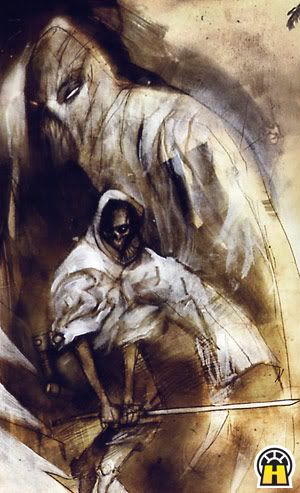
Chaos largely reigned for the next 250 years EDITOR'S NOTE: DARTH CHAOS? until a powerful Sith leader emerged. Known only as the Dark Underlord, his presence was clouded with rumor and Sith folklore. Some said he was called from the realm of Chaos by an inexperienced Sith acolyte who was never heard from again. Others even speculated that the Dark Underlord was the spirit of the Lettow general Xendor himself. EDITOR'S NOTE: YEAH. THAT WAS MY GUESS. (?) The only thing that was certain was that he was a bloody marauder of the first quarter of the New Sith Wars.
Consolidating a large Sith group known as the Black Knights on the planetoid Malrev 4, the Dark Underlord was one of the few Sith powerful enough to actively take the battle to the Jedi during this era, hacking through battlefields with his twin Sith swords. EDITOR'S NOTE: TRY SAYING THAT THREE TIMES REALLY FAST! (TWIN SITH SWORDS.....) However, the Jedi Master Murrtaggh cut a deal with Mandalorian mercenaries, who staged a diversionary attack on the Dark Underlord's forces. EDITOR'S NOTE: WHAT'S MANDALORIAN FOR "HEY! LOOK OVER THERE!"??While the Dark Underlord's Zeltron commander faced the Mandalorian intruders, Master Murrtaggh stole into his enemy's territory and assassinated the Sith Lord, martyring himself to the dark side in the process.
The last quarter of this bloody, backstabbing period saw the rise of the Dark Lord Belia Darzu, the major historical intermediary between Darth Rivan and the last Sith of this era, Lord Kaan and his Brotherhood of Darkness. A changeling and master of monster creation, Darzu was infamous for assimilating her conquered enemies into her own army, the Metanecrons, though the conversions were anything but voluntary. Using the Sith power known as mechu-deru, she created the frontline of her force: hulking part-creature, part-machine technobeasts infested with nanogene droids.EDITOR'S NOTE: LET'S PAUSE A MOMENT AND DIGEST THAT SENTENCE. HUH??? In combat, the tiny droids could infect their enemy, rewriting the unfortunate being's genetic code until she became an undead technobeast herself. Another sizable portion of Darzu's army was made up of her dead opponents, spurned to life by Sith incantations. EDITOR'S NOTE: COULDN'T YA KINDA SMELL THEM COMING A MILE AWAY?! Darzu's apoptotic army was ultimately sabotaged by Mecrosa poisoners, ending her evil. Centuries later, the Emperor's Hands Roganda Ismaren and Blackhole would use Sith scrolls preserving Darzu's secrets for their own sinister purposes.
Eventually the prominence of the Darth lineage was reestablished. The narcissistic Dark Lord Kaan ruled the Brotherhood of Darkness with an iron fist in the final days of the New Sith Wars. He commanded his Sith followers to create a Thought Bomb that wiped out both their forces and the Jedi enemies. This left the Dark Lord called Darth Bane the last Sith standing.EDITOR'S NOTE: BANE WAS THE ONE WHO SKIPPED THE MEETING, SO HE DIDN'T GET WIPED OUT WITH EVERYONE ELSE. SMART BOY. (I AM SUSPICIOUS OF BOSSES WHO CALL TOO MANY MEETINGS, MYSELF) With his apprentice Darth Zannah, Bane reshaped the Sith Order with two rules: henceforward, the Sith would only be two in number and until such time as they revenged themselves on the Jedi, they would keep their existence a secret.
Cults and Acculturation
The Jedi heard next to nothing of the Sith after the Battle of Rusaan. There were the vague threats by darksider Kibh Jeen at his moment of desperation during the Dark Jedi Conflict (circa 150 years before the Battle of Naboo), who spouted seeming gibberish about there always being no more or less than two Sith, but few Jedi gave his mad utterances any credence. EDITOR'S NOTE: LISTEN YOU SHOULD. OUT OF YOUR IVORY TOWER YOUR JEDI DERRIERES SHOULD BE. But then the Sith cultists began emerging. These "Sith" were disorganized and harmless for the most part. Many were merely youths in rebellion, without any solid idea of Sith doctrine or even any Force-sensitivity. EDITOR'S NOTE: SORT OF THE SITH VERSION OF VANILLA ICE? But not all of them.
One of the more dangerous cults was the Thyrsian Sun Guard. Not Force-sensitive, nonetheless these soldiers-for-hire were fearsome fighters. Consolidated in the Thyrsus system by Darth Sidious, the Sun Guard wore helmets reminiscent of the elite Senate Guard, although instead of ceremonial robes these Sith mercenaries were mailed in black armor from head to foot. Several of these Sith mercs guarded Sidious' Coruscant stronghold, and were also instrumental in the Dark Lord's plans surrounding the events of the Battle of Naboo, assassinating a discreet, though pivotal, number of Senators prior to the election for a new Supreme Chancellor. However, after Sidious' schemes ran their course, Count Dooku had most of these devotees killed by his executor Asajj Ventress -- though more than a few of the most fanatical Sun Guards found their way into Chancellor Palpatine's Red Guard.
One Sith cult can trace its origins back to the days of the Great Sith War. Larad Noon was one of the Jedi corrupted into the Brotherhood of the Sith by Exar Kun. When Kun and his Shadow Hand Ulic Qel-Droma were defeated, Noon and the other Sith acolytes fled to various parts of the galaxy. Some flew to the Expanse, dooming themselves and the Sith of House Mecetti.
Noon, however, was forever scarred by Sith ideology and the countless deaths he caused. He distanced himself from the Jedi and became a recluse on the moon Susevfi. Here he discovered a peculiar ore called cortosis capable of rendering lightsabers inoperative on contact. From this ore he fashioned a suit of armor to protect himself against the Jedi he believed would inevitably come, though in actuality, none did. Noon died alone, survived only by his journal in which he wrote extensively on his theory of Jiaasjen or "integrating the shadow." It was Noon's attempt to amalgamate his Jedi learning with his Sith experiences in order to justify the atrocities he committed and to keep himself from going insane with guilt. EDITOR'S NOTE: DOESN'T SOUND LIKE THAT WORKED OUT TOO WELL?
Thousands of years later, during the Clone Wars, an Anzat Jedi named Nikkos Tyris learned of his predecessor, the Jedi Volfe Karkko, and how he fell to the dark side. Curious, Tyris made a great effort to obtain Karkko's apocryphal teachings in which he found frequent reference to and snippets from Sith tomes. Looking on Karkko as a role model and lured to Count Dooku by his possession of one of Karkko's most cherished Sith holocrons, Tyris was slowly seduced into the darkness. Claiming he'd found the Saarai or "True Way," Tyris split from the Jedi Order, attracting many Jedi to himself, including the infamous Bpfasshi marauders. However, Tyris and most of his followers were slain by Jedi forces.
Tyris was survived by only a handful of Jensaarai pupils, Sith for "Followers of the True Way." Their training was far from complete, but as such they had not been corrupted as Tyris had. Tyris' primary apprentice felt it was her duty to make certain her master's ideals, or what she perceived to be his ideals, didn't die, and that the "evil" Jedi wouldn't triumph. She took it upon herself to continue Tyris "truth" by finding what Sith texts she could. She was largely unsuccessful, but when she came to Susevfi, she found Larad Noon's journal. The result was the creation of a Force tradition that uniquely blended Sith and Jedi teachings.
Proliferation among the Sith cults can at least in part be attributed to one man, or one Quermian, as it were: history professor Murk Lundi, who made his career exploring esoteric topics. An excellent teacher but a mediocre researcher, he found himself struggling in the "publish or perish" world of academia. EDITOR'S NOTE: ODDBOB, ODDBOB! THIS GUY SOUNDS LIKE A FRIEND OF YOURS, HUH??!!
In peril of losing his position at the University of Coruscant, Lundi began to explore topics outside of stale classics like Xim the Despot and the Atrisian Empire. Eventually, he zeroed in on a single controversial subject: the Sith. To advance his research, the academician delved into the trenches, creating a communications network between the disparate Sith sects to grant himself greater accessibility to information.
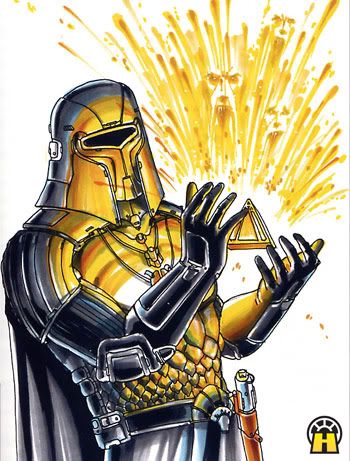
Then, Lundi learned of the ultimate prize. A Sith holocron was buried deep beneath the oceans of the planet Kodai. Lundi attempted to retrieve the artifact, but was stopped by the Jedi.
Afterward, one of his classroom students almost succeeded where the teacher had failed, but the pupil was destroyed by one of Darth Sidious' Sun Guard mercenaries and the holocron was restored to Jedi hands. Lundi later went irrevocably insane and died a madman's death. EDITOR'S NOTE: YEP. DEFINITELY A FRIEND OF YOURS, OB.
Meanwhile, the Jedi Council ultimately entrusted the Sith holocron to House Pelagia's extensive holocron library in the Tapani sector.
A Dark Religion
The order of the Prophets of the Dark Side goes back nearly a thousand years to the three-eyed mutant Darth Millennial, a Sith Shadow Hand whose instincts drove him to see more sense in Lord Kaan's cutthroat Rule by the Strong than Bane's limiting Rule of Two. Gifted with the ability to foresee the future, Millennial was often at odds with his Sith Master, Darth Cognus.
Barely escaping his Master's wrath, Millennial fled to the planet Dromund Kaas. There he meditated on Sith teachings and combined them with the theories of early and pre-Republic thinkers like Plaristes and Dak Ramis. The result was an intricate religion the dark sider called the Dark Force. Hailing himself as a prophet chosen by the will of the Force, Millennial and his religion attracted many Force-users of considerable intelligence, as well as multitudes of naïve Sith cultists. Those who disagreed with the tenets of the Dark Force were labeled heretics and destroyed.
Centuries passed and so did Millennial, but his faith lived on, at one point seducing the Jedi Kibh Jeen. Eventually, Darth Sidious discovered the secret order, and bent these Prophets of the Dark Side to his will. When the Prophets were obliquely reintegrated into Darth Bane's line of the Sith, Palpatine secretly gave them the duty of providing early training for some of his dark siders. Occasionally, Palpatine asked the Prophets to train a devotee to the exalted levels of Emperor's Hand, Emperor's Eyes, or Emperor's Reach.
Just as the Prophets only ever trained one individual to the rank of Emperor's Reach for Palpatine, likewise they only trained one to the status of Emperor's Eyes. However, this latter individual was one of the Prophets' own.
A former Nightsister of Dathomir, High Prophetess Merili was one of only two Emperor's Eyes that Palpatine ever employed. The Emperor's Eyes were those Dark Side Adepts with a particular propensity for seeing into the Force. Like the other Prophets, Merili was able to gaze into the future; the invaluable difference, however, was that Merili's mind seemed to partially exist there. She was thus not only able to witness coming events with uncanny clarity, but on rare occasion she was able to in fact manipulate them, much like a skilled Jedi Master can influence the outcome of a conflict using Battle Meditation. Needless to say, the stresses of temporal ambiguity made Merili's hold on reality tenuous at best. Of Palpatine's other Emperor's Eye, a mutant called Triclops, little is known, save that Palpatine considered the being a great personal failure. EDITOR'S NOTE:GIGGLE. NICE. THIS IS POSSIBLY BECAUSE HE EXISTS ONLY IN NON-CANON KIDDIE LIT.
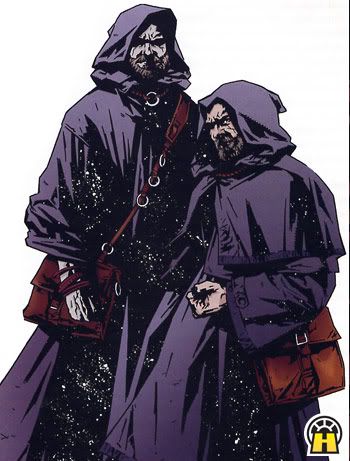
The Prophets of the Dark Side have always maintained their sovereign right to accept additional adherents of the Dark Force at their discretion. The Prophets have three ranks in their order: acolyte, followed by prophet, with each subdivided into sub-ranks such as "Lesser Prophet" and "High Prophet," and ultimately the overarching position of Supreme Prophet (all acolytes and prophets of lesser orders are easily identifiable by their lack of a beard). EDITOR'S NOTE: THE CHICKS, TOO? The Prophets were one of Palpatine's most jealously guarded secrets, kept concealed even from Darth Vader for a time.
When Supreme Prophet Kadann adamantly disagreed with Palpatine concerning a guaranteed Imperial victory at Endor, Palpatine sent his Inquisitors to Dromund Kaas to reeducate Kadann's priesthood, causing the ecclesiastics to take flight to the secluded planet Bosthirda.
After Endor, while the Prophets were believed dead, former Imperial Intelligence Director Blackhole -- himself a former Prophet of the Dark Side -- helped acting-Emperor Sate Pestage set up a "Dark Side Church" on Imperial Center with a clergy of false Prophets, including a diminutive Bimm and a Null to impersonate the current Supreme Prophet Kadann and his High Prophet Jedgar, respectively. As religion had been largely outlawed under Palpatine, these charlatans filled a tremendous spiritual need for the population and became highly idolized. This later empowered the fakers to actually dictate rule of the Empire. They determined to bestow Emperorship on whomever secured the glove of the dead Darth Vader's severed right hand -- a Mandalorian crushgaunt which Vader had fitted around one of Lord Kaan's indestructible Sith amulets. The Imperial Grand Admiral Afsheen Makati eventually destroyed these prophet imposters, though one of them, Orloc, escaped to continue his con.
Meanwhile, the real Prophets continued to plot from the planet Bosthirda, until they were found by their most dangerous and embittered pupil, Azrakel, on a tip from a mysterious source. Armed with his double-bladed lightsaber and Darth Vader's prophesied gauntlet, Azrakel managed to destroy a number of the flabbergasted Prophets, including Supreme Prophet Kadann, before being permanently put down. Though the surviving Prophets thought they were now safe, within minutes of Azrakel's death, the Dark Lady Lumiya and her apprentice Carnor Jax finished the job. EDITOR'S NOTE: JUST TO SHOW IT'S ALWAYS SOMETHIN.
Life After Darth
The problem Bane addressed when he bound the Sith to secrecy and their number to a pair was that only under such conditions could dark side ambition be checked. But Emperor Palpatine eventually broke the rule of secrecy and "bent" the rule of two by keeping a multitude of dark siders in reserve. Like his emperor, Vader also bent the rules, secretly training Sith disciples of his own so that he himself might usurp the title of Sith Master. Among them were Lumiya, an Imperial double-agent-turned cyborg, and Flint, a stormtrooper whose father was killed by General Grievous during the Clone Wars.
Vader had planned to pit these pupils against one another as past Dark Lords had done, taking the victor as his Shadow Hand. The Sith Lord died before that could happen, however. Flint, who had looked to Vader as a father, felt the loss deeply. He retreated to the planet Vjun where he mourned within Vader's Bast Castle. It wasn't long before he was found there by Lumiya. Though they'd never seen one another, without words they came to a mutual understanding. A towering statue of Vader looked on as Flint ignited his lightsaber and Lumiya her Sith lightwhip. The furious battle left both warriors battered, but in the end Flint's despair was no match for Lumiya's hatred, and the roles of master and the apprentice were determined.
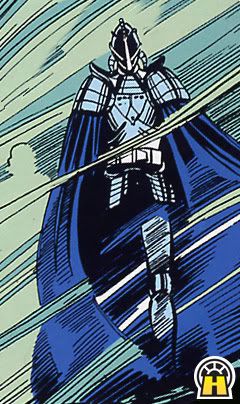
Lumiya tasked Flint with subjugating the Phelleem sector and killing Luke Skywalker while she prepared an alien species called the Nagai (or N'Gai) for the invasion of galactic space. Nothing could make Flint happier, but instead of killing Skywalker, Flint was persuaded by an old friend to turn back to the light. For many years thereafter, Flint was kept in a cell of Mandalorian iron on an Alliance safeworld, healing from the traumatic influence of the dark side. Eventually, he returned to his home planet Belderone to live out a simple life. Lumiya vowed to deal with Flint when circumstances allowed and sought a new apprentice. She didn't have to look far.
As the dominant black color of his robes suggests, the dark sider Carnor Jax had ties not only to the Imperial Royal Guard, but his father was once a Sith mercenary of the Thyrsus Sun Guard who was killed by Darth Sidious following his failure to recover King Adas' holocron. Jax himself was a superior soldier, savvy and ambitious. Like Flint, he excelled as a stormtrooper, but Jax was handpicked from the ranks of the Blackhole's special stormtrooper unit for the Royal Guard.
After Palpatine's death, a number of Royal Guards partook in a mass suicide. Some distraught guards joined the cause of Lord Shadowspawn, EDITOR'S NOTE: SHADOWSPAWN? TINKERBELL WAS TAKEN, I GUESS? while others found solace in the words of the Prophets' Church of the Dark Side, who promised the Emperor would one day return. Jax was disgusted at the weakness he witnessed blind loyalty produce and resolved to have no part of it. Thus, it was easy for Jax to transfer allegiance from Palpatine to his successor Sate Pestage, then again to Empress Ysanne Isard. Ultimately, Jax was loyal only to himself. EDITOR'S NOTE: THAT'S THE THING WITH EVIL...IT'S ALL ME ME ME.
That became problematic, however, when Isard transferred Jax and a number of other Royal Guards into the hands of Lumiya as part of a deal. Sensing the Force in Jax, Lumiya offered him something altogether different than any of his previous masters: the power of the dark side. EDITOR'S NOTE: OH. SEE I THOGUHT THEY WERE GONNA SAY SEX. (SILLY ME; I GUESS SOMEONE HAD ALREADY OFFERED HIM THAT?)
After giving Jax limited training, Lumiya informed her apprentice of her need to now gather the necessary elements to rebuild the Sith Order. The New Republic already thought Lumiya dead, and the circumstances surrounding her encounter with the Emperor's Hand Mara Jade on Caprioril led the Empire to the same conclusion. Before she disappeared on this quest, however, Lumiya ordered Jax to infiltrate the Empire's upper echelons and prepare, by whatever means necessary, for the ultimate threat to the Sith legacy. Jax pursued this agenda, collecting political and military allies and incriminating secrets within the Imperial Ruling Council and using Dark Side Adepts like Sarcev Quest to learn new Force powers. Jax soon had the Empire eating out of his palm.
Then came the unthinkable. Emperor Palpatine, dead for six years, miraculously returned. EDITOR'S NOTE: BUMMER. Suddenly, Jax realized what threat his master Lumiya had been referring to, and was not prepared to give up the power he'd accumulated. As a Force-sensitive Royal Guard, Jax easily became part of the Reborn Emperor's elite and trusted Sovereign Protectors. With Quest's help and particular relish, Jax convinced the Imperial Ruling Council to bribe Palpatine's physician into poisoning the clones the Emperor was using to stay alive. Palpatine died his last death as a result, and Jax set himself up as Imperial ruler.
Afterward, he attempted to reestablish communication with Lumiya -- not to rejoin her but to lure her into a trap. That's when one of Palpatine's loyal former Royal Guardsmen killed him.
Lumiya was nonetheless thankful, for not only had Jax permanently eliminated Palpatine, but before his attempted betrayal, he'd passed on word to her of a mysterious stranger called Nom Anor who was interested in a possible alliance with the Dark Lady. EDITOR'S NOTE; NOM ANOR, THE SPY FROM THE YUUZHAN VONG. JUST TO PROVE THAT NOT ALL EVIL COMES IN A SITHY PACKAGE.
Evil Lives
"Will the Sith ever return? It's a probabilistically historical inescapability. But, what makes you think they haven't already? [uneasy laughter]." -- Lecture recording from The Lundi Series, Vol. 5: Historical Reincarnation, Soundbyte Texts
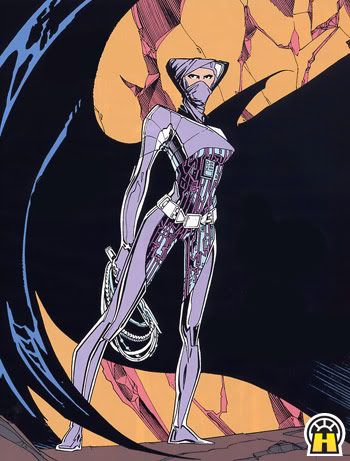
Despite all the efforts of the Jedi and the Republic, the Sith seem to be an inextinguishable plague. Seven years after the Battle of Endor, when Luke Skywalker established an academy with the intention of rebuilding the Jedi Order, the spirit of the ancient Sith Lord Exar Kun returned to prevent the Jedi Brotherhood's resurrection. Three short years later, another Sith daemon, this time the Dark Lord Marka Ragnos, also was called back from the realm of Chaos to terrorize the galaxy. This latter event was not isolated. Some of the disciples of Ragnos had formerly been aligned with the dark sider Hethrir and his Empire Reborn, which had been defeated only a short time prior. Worse, soon after the encounter with Ragnos, the lifeless body of the reformed Sith acolyte Flint was found on Belderone: an ancient Jedi lightsaber in hand, a cauterized hole through his throat.
The Force seethed with the suggestion of a grand, sinister scheme. But Luke could only guess at who was pulling the strings. Either the dark sider Irek Ismaren or Jaalib Brandl? One of Luke's rogue Jedi students, perhaps...Brakiss or Dolph? The list of suspects was considerable. In the wake of these events, Master Skywalker began to keep a formal compilation of known dark siders and to actively unearth any facts on the Sith that he could find, some of Doctor Lundi's teachings among them.
On the world of Korriban, through the ancient Sith Oracle and with King Adas' holocron now in her possession, the Dark Lady of the Sith Lumiya watched circumstances unfolding with deep satisfaction. EDITOR'S NOTE: THE BIG MEANIE!
From the Dark Side Compendium
To grasp the depths and mercurial intents of the dark side, there is no better authority than the Sith architect who brought about its greatest return. Darth Sidious spent decades ruminating on the nature of the dark side, and as Palpatine, he sought to pen the most comprehensive tome on the nature of darkness and the practices of the Sith. What follows is material researched by Sith experts Tom Veitch, Michael Allen Horne, Bill Slavicsek and JD Wiker.
While his Vizier and ministers maintained the day-to-day operation of the Empire, Palpatine spent decades frequently in seclusion, in meditation and study, on a masterwork of his thoughts and teachings. No one can say when he first began the work, but his advisors suspect it dates back to the time he first embraced the dark side. Numerous beings have succumbed to its temptation over millennia, but few have ever pursued its power as relentlessly as Palpatine.
The dark side, as far as its servants are concerned, is obviously stronger and easier than the Light. What Palpatine realized was that the dark side had never gained the fame the Light held because it was a personal, secretive thing. The Light was good for simple tricks and for the altruistic, but such things were useless to one who knew the things the Force made one capable of. EDITOR'S NOTE: SO IT REALLY COMES DOWN TO PUBLIC DISPLAY VS. PRIVATE PLEASURE? (SO THE JEDI ARE ACTORS.....AND THE SITH ARE...PRODUCERS?)
ANYONE HAVE A MEL BROOKS SONG SCEAMING TO BURST OUT, RIGHT ABOUT NOW????
Palpatine became convinced the dark side was ignored because few had the courage to pay the price it demanded. There was no great collection of dark side lore, nor any gathering of its masters. Realizing the task that lay before him, Palpatine knew he must begin at once to attain control over the dark side.
With the resources of a galaxy at his disposal, he gathered the greatest works of knowledge from over a million worlds. He studied the Force in all its guises throughout the galaxy, whether it was the shamanism of Jarvashqiine or the tales of the Tyia. Coupled with perversions of the secrets he ripped from the living minds of Jedi he captured during the Purge, he learned more than he ever expected.
One such victim was Ashka Boda, possessor of the famed Jedi Holocron itself. With this artifact in his grasp, he had little need for any more living Jedi, save as pupils to corrupt.
He sifted this lore till he could find every secret he needed to continue his studies. He had long ago gone beyond any knowledge to be found in the recovered teachings of the Krath or the Heresiarchs. Since then, his studies had principally been experimental. He gathered this knowledge, mostly crude and simplistic variations on traditional Jedi teachings, into a great assemblage of Dark Side Lore.
He completed two volumes in this Dark Side Compendium: The Book of Anger and The Weakness of Inferiors. EDITORS' NOTE: I LIKE BOTH OF THOSE TITLES A LOT! (I RELATE TO BOTH OF THEM A LOT!) OH NO. I'M A SITH! (AT LEAST I'M NOT A MUGGLE.). The Emperor's third volume, The Creation of Monsters, was still in manuscript. Prior to his death above the Pinnacle Moon, the Emperor had planned hundreds of additional volumes. With the immortality his clone tanks provided him, he thought he literally had all the time in the universe with which to probe the limits of the Force.
The Book Of Anger
Emperor Palpatine's first volume deals with the use of emotion to control the Force. He considers anger to be the most potent emotional form. With anger, the Sith can call upon the dark side, harnessing it for great power and destruction. Palpatine teaches that anger and rage, mixed with intelligent control, call upon the dark side with a very fine level of control, and can even kill from a great distance. EDITOR'S NOTE: PLUS, IT REALLY FRIGHTENS THE DOG.
An excerpt, on the creation of Force Storms:
I have learned that Anger and Will, joined together, are the greatest power.
I have learned to meditate upon Anger and Will with clarity and precision, and I have learned to open the hidden reservoirs of dark side power.
Anger concentrated by Will in the vital center of the body creates a portal through which vast energies are released -- the energies of the dark side of the Force.
Standing watch with the mind, in my meditation of Anger, I have slain my enemies from great distances, through the dark side power that permeates the galaxy. I have created lightning, and unleashed its destructive fire.
Using this knowledge, I can unleash the dark side energies that are all around us, even to shatter the fabric of space itself. In this way, I have created storms.
The Emperor also wrote:
Many claim to have found serenity, and through serenity to have overcome anger. Such arrogance is astounding. These fools have never faced their anger, and thus have no idea whether they have truly overcome it or not. True calm is only achieved through testing the limits of one's anger and passing through unscathed. The capacity for this ability lies within everyone, though most fear to test their own strength, and are thus considered at best weaklings, and at worst irresponsible.
The Weakness of Inferiors
This second book teaches control, without violence, over the innocent, the ignorant, and "all inferiors."
Palpatine's main philosophy is quoted below:
1) ALL POWER COMES FROM OUTSIDE THE WEAK. The weak have never been known to believe in themselves or in their ability to wield power.
2) THE FACE OF AUTHORITY. The weak live as in a dream. All their thoughts, actions, and urges are governed by the face and the voice that controls this dream. The face and voice they have learned to obey. The face and voice of Authority.
3) THE LAW OF FEAR. A consequence of the first two tenets is that the weak live in fear. The mere suggestion of violence from one in authority is enough to inspire their obedience. How can one who doesn't believe in his own powers stand against the power of another? It is impossible.
4) THE WEAK DO NOT UNDERSTAND THE FORCE. The Force is the ultimate means to gain authority over the weak. The weak do not understand the Force. The weak do not sense the Force, therefore how can they understand or use the Force? So it is that the weak are at the mercy of those who know and use the power of the Force. The proper use of the Force can inspire awe and obedience in the weak. EDITOR'S NOTE: THE WEAK DON'T SOUND LIKE ANY FUN. LET'S NOT INVITE THEM TO OUR PARTY.
It has been said that anyone who knows the ways of the Force can set himself up as a King on any world where only he knows the ways of the Force. Any Jedi could do this. But the Jedi, fools that they are, adhere to a religion in which the Force is used only in the service of others.
How shortsighted of them. Is that not why they lost the galaxy to the dark side? In these cantos and the hundreds of thousands that follow, it is apparent that the Emperor has plumbed depths of darkness unknown before. What is known is that the Emperor gathered all the greatest lore of the dark side and collected it. This cost him greatly, as the dark side consumes its servants even as its followers consume each other.
Also from the second book:
Inferiors continually endanger their own lives and the lives of others through poor decisions, reckless behavior, and simple inability to engineer the reality of their ambitious dreams. They are like children, crying in frustration because they do not comprehend their own limitations.
These weaklings need structure -- to be shown their place in the existing social structure. It is left to the wise and powerful to provide that structure in order for civilization to survive and thrive in the galaxy. Those who cannot -- or will not -- accept that peace and order are far more important than their own selfish desires must be removed from society before they can inflict any lasting damage. EDITOR'S NOTE: I'M PRETTY SURE THAT A FEW OF THE MANAGERS AT MY OLD EVIL AD JOB...THE FEW MANAGERS WHO COULD READ....MUST HAVE POPPED OPEN THIS BOOK FROM TIME TO TIME. IT IS SOUNDING EERILY FAMILIAR.
The Creation of Monsters
Palpatine perished before he could complete this volume on the ancient art of Sith alchemy. This book provides not only detailed schematics for Sith alchemical apparati, but guidelines and advice on how to avoid the pitfalls of tinkering with the physical compositions of living, independent creatures.
An excerpt:
Conquer the temptation to create specimens that are superior in every way. The danger of such monstrosities being turned against you is too great. Instead, focus on instituting controlling weaknesses into each and every beast you construct. Make it strong where you are weak, but weak where you are strong. It must have a fatal flaw that you -- and only you -- know how to exploit. And always, without fail, be prepared to destroy your most valued creation... or be prepared to be destroyed by it."
EDITOR'S NOTE: SOME PARTING SITH ---
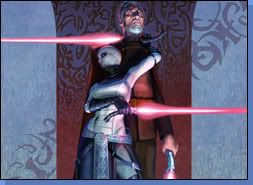



EDITOR'S NOTE: HERE YA GO, OB. DOES THIS MAKE UP FOR THE 'READ-WITH-YOUR-LIPS' COMMENT AT THE BEGINNING OF THE POST?
NAH...DIDN'T THINK SO......
EDITOR'S NOTE: HERE IS A LITTLE LITMUS TEST, A RORSHALK TEST, IF YOU WILL. WHEN YOU LOOK AT THIS NEXT POSTING, DO YOU THINK THE PEOPLE WHO DID THESE PICTURES ARE NORMAL?
Fan Eyes for Plastic Guys
Star Wars fans never seem to tire of making the universe around them more interesting. If they're not out raising money by standing in, of all things, a line, they are building replica lightsabers for their costumes, molding armor, shooting fan films, and ... making custom clothing for 12-inch Star Wars action figures. EDITOR'S NOTE: LET'S RE-READ THAT LAST BIT AGAIN. 'MAKING CUSTOM CLOTHING FOR ACTION FIGURES'. I GUESS IT'S BETTER THAN ROBBING CONVENIENCE STORES, OR MUGGING LITTLE OLD LADIES.
I GUESS.....
The custom clothing in our fabulous photo gallery represents hours and weeks of painstaking work on the costumes alone, not to mention the time invested posing the figures in quality glamour shots. EDITOR'S NOTE: NOT TO MENTION....It's hard to imagine how difficult it must be to knit tiny sweaters with even tinier needles, hand-stitch minuscule trim, and mold custom armor that fits toy torsos. EDITOR'S NOTE: AND THEN YOU HAVE TO CONSTANTLY BE ON THE LOOKOUT FOR TOYS THAT TRY TO IMMOLATE THEMSELVES FROM SHAME. (CHASING ACTION FIGURES HITHER AND YON. IT'S EXHAUSTING!)

Master and Padawan hand-knit sweaters by Nancy Lutz.
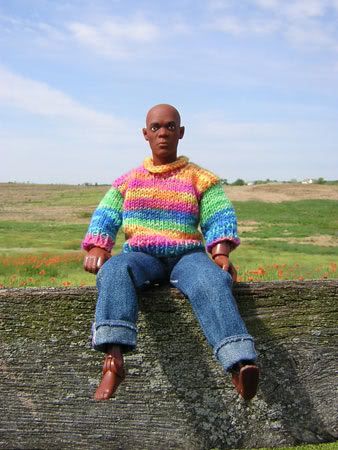
Sweater by Nancy Lutz. "Thanks for the excuse," Lutz writes, "I haven't done pictures like these for ages and I'd forgotten just how much silly fun it is."

Custom clothing for Sith afternoons in the country by Lynanne Schweighofer. EDITOR'S NOTE: LISTEN! I THINK I HEAR HIM SINGING " THE HEATHER ON THE HILL"!

Qui-Gon's country clothes by Lynanne Schweighofer
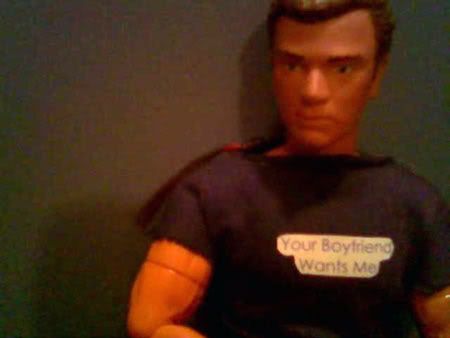
A shirt worn by actor Topher Grace in the movie Ocean's Twelve inspired Yav Cassidy to create this tiny replica for her Obi-Wan figure. EDITOR'S NOTE: THIS IS THE PRICE YOU PAY FOR HANGING OUT WITH THEATER FOLK.
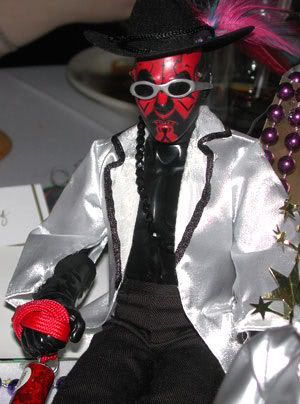
Tracy Duncan submitted the photo of Nancy Deet's "Pimpmaster Maul." "I'm not sure about her inspiration, but I think it was the hat. I mean, it's a freaking awesome hat," writes Duncan. "It wasn't the hat. It was the cane," responds Deet.

When TK0.5 traveled the Midwest, he met the local characters. Kathy Van Beuningen, Commanding Officer of the Midwest Garrison of the 501st Legion, customized the troopers armor for his visit.

Beth Dibble provided the cycle to go with the kilt created by her friend Shelba Bauermeiester. EDITOR'S NOTE: ACTION FIGURE PORN?

Padmé's wedding dress by Kathy Van Beuningen. Talk about attention to detail! EDITOR'S NOTE: GORGEOUS!

"I used the Jar Jar Binks talking alarm clock doll," writes Van Beuningen. "I found a neutral-colored perfectly diamond-textured piece of home décor fabric that needed to be dyed to a pumpkin color to more closely match the color of the character's costume." EDITOR'S NOTE: THIS ONE IS ALSO VERY GROOVY!
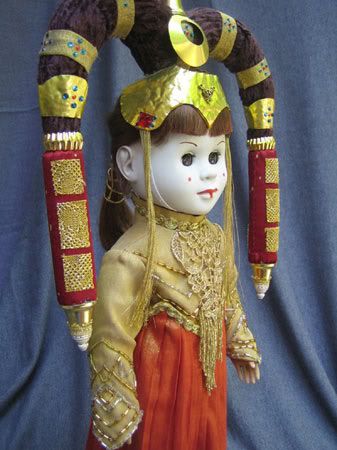
Queen "Ami-doll-a" by Kathy Van Beuningen. Van Beuningen started with an 18-inch "American Girl" doll.

Imperial Girl by Kathy Van Beuningen. EDITOR'S NOTE: HOW TERRIFYING! MUCH SCARIER THAN WHEN JANGO'S FACE IS UNDER THAT HELMET!
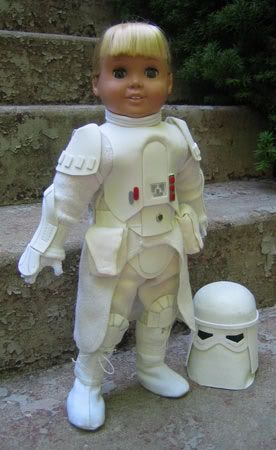
Imperial Girl snowtrooper by Kathy Van Bueningen. EDITOR'S NOTE: THE STORMTROOPERS WERE BLONDS?! WELL NO WONDER THE EMPIRE FELL!
EDITOR'S NOTE: I THINK I NEED TO GO SCRUB MY EYEBALLS AFTER SOME OF THOSE. IT IS WITH GREAT RELIEF THAT I POST THE REGULAR STAR WARS PICTURES.

This conceptual paint scheme for a Jedi starfighter definitely has a hot rod touch.

Both the Empire and the Rebels can now strike -- or spare -- with this new set of bowling balls produced by Brunswick. From the collection of Dark Lord VaderPainter.
EDITOR'S NOTE: WOW. SERIOUSLY GORGEOUS. I THINK I MIGHT HAVE TO TAKE UP BOWLING!

Obi-Wan Kenobi's blue Jedi starfighter, which replaced his ill-fated red one on his mission to Utapau.
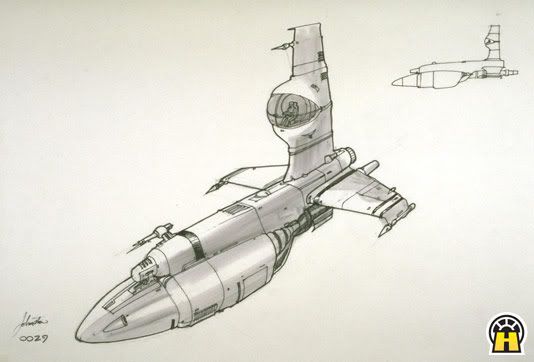
A curious concept vessel developed by Joe Johnston during the making of A New Hope.
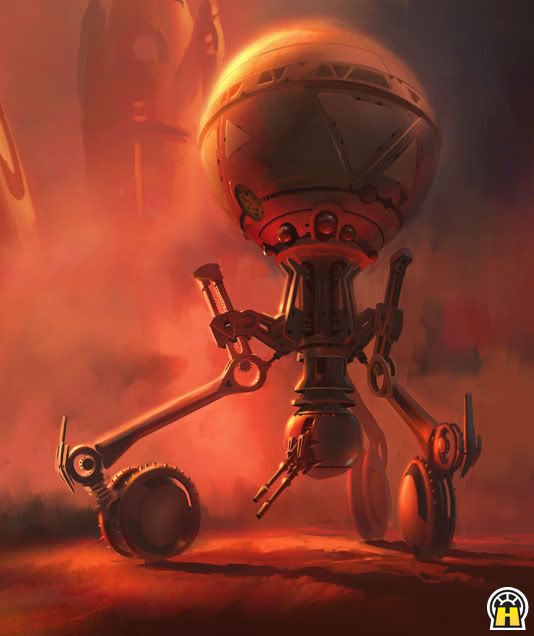
A variation of this unused Episode II droid concept by Ryan Church would appear in Episode III as an octuptarra droid
EDITOR'S NOTE: AND LET'S CLOSE OUT THE WEEK WITH THE NEXT 2007 SNEAK PIC ----

Not exactly a scenic spot that would make its way into a galactic travel brochure.
EDITOR'S NOTE: I'M OFF FOR MY FAMILY TRIP, DWEEBPALS! HAVE A GREAT WEEK, AND I'LL START POSTING AGAIN SOMETIME AROUND THE 4TH OF JULY HOLIDAY. (OR SHORTLY THEREAFTER).


0 Comments:
Post a Comment
<< Home